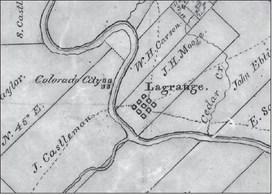“Footprints of Fayette”
Colorado City
Some thirty-five years ago, in another life, one of my hobbies was to guide small groups on canoe/kayak trips down the Colorado River. On this particular trip, my friend Gary and I made the run from Plum Park to La Grange. It was an easy one-day float, passing by many interesting historic and geological features along the way.
We were nearing the end of the trip, having run the only stretch of white water in the County, and explored Robbers Cave at the base of Chalk Bluff. With the La Grange railroad bridge trestle in sight, I led the tired paddlers to a small sandstone ledge along the western bank of the river where we disembarked for our last break of the day.
Standing there securely on the ledge, I tell them of the 1839 river trip of William McKinstry, whose 1840 booklet, Colorado Navigator, described this ledge as a landing for Colorado City.
We were on that stretch of river just below the Fair Grounds where it makes a slight “jog” to the west, as if trying to avoid some unseen obstruction in its path. The terrain to the east was all uphill, while to the west, the tree line flowed gently along with the river, lower on the horizon. The banks here were lined with river ferns, emerald green, growing wherever they caught the morning sunlight.
I made a mental note of the location as we headed on to our destination.
The John Castleman league, A-31, was on the west bank of the Colorado River, across from the John Henry Moore land grant, the future site of La Grange. The Castleman Leage, almost 5,000 acres, ran south to Buckners Creek and north along the river for some three miles, all prime farmland.
The Castlemans came to Texas as early as 1821, where the Sylvanus Castleman Family was part of the Old 300 settlers in Austin’s Colony. After gaining independence from Mexico, a second wave of settlers came to Fayette County, lured by the prospect of cheap land and an opportunity to start over.
John W. Dancy came to Fayette County in 1837, where he purchased large amounts of Castleman land from his friend Henry Manton. Dancy built a home and a large plantation at that location.
As the tiny settlement that would become La Grange grew, one of Dancy’s dreams was to develop a rival city, a twin, on the west side of the river. Purchasing additional land from Manton, he surveyed, platted, and staked out the new town, which he had named Colorado City.
Dancy sought out investors to join him and incorporated the venture; major stockholders were Henry Manton, Thomas Mathews, William Paxton, Enoch Jones, C. P. McKennie and Samuel Allen.
Advertisements ran in all the major newspapers of the time. From the Houston Telegraph and Texas Register, March 24, 1838: “COLORADO CITY, formerly known as Electra, on the La Bahia Crossing, eminently beautiful; good, pure and never failing spring water, the land equaling in fertility to the alluvion of the Mississippi, the charms of romantic scenery, near beautiful hills where a fountain (spring) rises, abundance of lumber and stone, the purity and transparency of the Colorado River, soon to be navigated by steamboat, its healthiness and centrality unequaled in the Republic, suitable for a seat of government.”
Some 5000 acres, 156 blocks of residential and commercial property were for sale. With the project (plat) still mainly on paper, the outlook was promising.
And then Mother Nature reached out and touched her people. Hundreds of miles upstream, the rain fell the normally placid little stream became an unstoppable raging torrent. That same flood of 1838 that drove Eliza Moore (John Henry’s wife) from her home in La Grange had dev- astating effects on the fledgling community of Colorado City across the river.
The dream had died. On Sept 18, 1841, the courts dissolved the corporation and distributed the land, 1,356 acres, between the remaining stockholders. By the late 1840s, the land use had reverted to farming and large plantations.
Dancy was successful in life. On his plantation, he experimented with new varieties of cotton and innovative irrigation techniques. In later years, he practiced law and served in both the Republic and State Legislatures. Henry Manton died in 1840 at age 47, but his son Edward would successfully manage the family business for many years.
Today, with our natural resources (sand and gravel) being removed at an ever-increasing rate, this area somehow remains a mainstay for corn and sorghum production in the County, with cotton trying to make a comeback.
Today, near the Colorado City location, the name Egypt Road conjures up images of the Nile Valley, while Golden Valley Lane can only be a promise of a better harvest next season.
Today a new Colorado City sits some 450 miles upstream of La Grange. It is the county seat of Mitchell County, founded in 1877, its a history in cattle, and has a population like ours.
The people there are friendly. The main difference is that one can jump across the river there and only get one foot wet.
References:
Colorado City file at Fayette Heritage Museum and Archives, La Grange Spellman, Paul N., Old 300: Gone to Texas. 2014.
McKinstry, William C., The Colorado Navigator. 1840.
Biographies at Founders Park, La Grange



